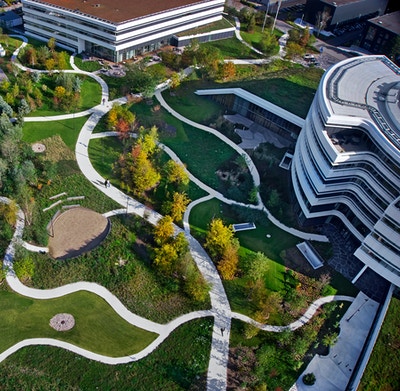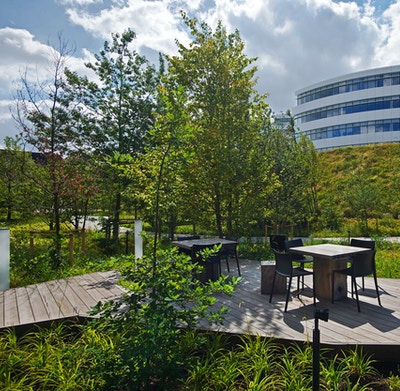Industrial zones and business parks are often associated with large-scale uniform buildings and vast asphalt surfaces, facilitating parking and infrastructure. Today these urban typologies, with their roots in modernist urban planning, are ubiquitous and line the periphery of most cities. The mono-functionality of these areas often apply to landscape as well as buildings, and as a result natural wildlife can easily be suppressed by lack of access to suitable habitats.

Origin/team:
SLA Architects
Henning Larsen Architects
Orbicon
Alectia
Skælskør Anlægsgartnere
UrbanGreen
Photography:
SLA Architects
Torben Petersen
Resources:
sla.dk
The landscape design for the headquarters of pharmaceutical company Novo Nordisk is inspired by the Scandinavian forests and hilly dead-ice topography, supporting a wide variation of natural biotopes in various ways. The planting plan shows a wide palette of native plants and has more than 1,000 new trees which over time will grow into clearly defined small ’forests’ and self-regulating biotopes. The park promotes vegetation, which evolves with natural succession and seasons, and dead trees are integrated parts of the landscape design, with the purpose of increasing the biodiversity and strengthening the park’s natural ecosystem, creating new habitats for bugs, fungi and larger animals. They also provide the park with the smell of natural decay and thereby a direct confrontation with the aesthetics of nature and its ecosystem.
The trees were hand-picked by the designers in specially selected nurseries before composed in relation to their natural habitat, their shape, their volume and in relation to the local microclimate to maximize shelter for the users of the park and for the office buildings. The trees also help to absorb all rainwater that falls on site. Depressions are planted with alder trees and other water tolerant species in order to contribute to the park’s ambitious climate adaption design. The landscape holds a 100% water balance, which means that all rainwater falling in the area and on the buildings is collected and reused for irrigation of the park’s many large trees and diverse vegetation. The biodiversity of the park is being monitored and new species has been found there. Also, the park has become a recreational destination for employees, visitors and local residents.












